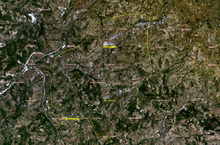

San Marino is located in Southern Europe, an enclave (landlocked) in central Italy, which it borders for 39 km. The third smallest independent state by area in Europe after the Vatican City and Monaco, San Marino is dominated by the Apennines. Located at 43°56′N 12°28′E / 43.94°N 12.46°E / 43.94; 12.46, it covers an area of 61.2 km (23.6 sq mi). Completely mountainous, only 17% of its territory is arable. Several rivers flow through the country, the largest being the Ausa, the Marano, and the San Marino River.
Climate
The climate of San Marino is a humid subtropical climate (Köppen climate classification: Cfa), with continental influences, having warm summers and cool winters that are typical of inland areas of the central Italian peninsula. Snowfalls are common and heavy almost every winter, especially above 400–500 m (1,300–1,600 feet) of altitude.
Political geography
Main article: List of cities in San MarinoSan Marino is divided into 9 castelli, or municipalities. They are:
- Acquaviva
- Borgo Maggiore
- Chiesanuova
- Domagnano
- Faetano
- Fiorentino
- Montegiardino
- City of San Marino (Città di San Marino), the capital town
- Serravalle
Protected areas
San Marino has no protected areas as of November, 2016. San Marino is defined as a Global 200 Ecoregions. San Marino has no threatened or endangered species.
International law
San Marino gave credence to and accepted the Convention on International Trade in Endangered Species of Wild Fauna and Flora, adheres to the International Convention for the Regulation of Whaling, and ratified the World Heritage Convention. They are members of International Maritime Organization and IPCC. They are signatories to the Convention on Biological Diversity.
Domestic law
While San Marino has no official protected areas, it has a law prohibiting the cutting down of any tree over 10 centimetres (3.9 in) in diameter, meaning that most trees within the country are legally protected. Under the FRA 2010 Categorization of Forests, all of the land area of San Marino is considered "Other land", with none being "Forest" or "Other wooded land". Despite the fact that 16% of the country is woodlands, predominantly of oaks and other broadleaves as Quercus pubescens, Fraxinus ornus, Ostrya carpinifolia, Acer obtusatum, Quercus cerris, Quercus ilex, Populus nigra, Salix alba. Shrublands and similar lands are dominated by Crataegus monogyna, Cornus sanguinea, Spartium junceum, Rubus ulmifolius, Rosa canina, Prunus spinosa, Quercus pubescens, Fraxinus ornus and Ulmus minor cover the 17%. Badlands are only 4% of the country, and less than 1% is covered by rivers.
References
- "Protected Planet". www.protectedplanet.net. Retrieved 19 November 2016.
- ^ "San Marino definition| Biodiversity A-Z". www.biodiversitya-z.org. Retrieved 19 November 2016.
- "List of Parties". www.cbd.int. Retrieved 19 November 2016.
- Lumbreras, Emilio Laguna (2001). The micro-reserves as a tool for conservation of threatened plants in Europe. Strasbourg: Council of Europe Pub. p. 75. ISBN 9789287146649.
- "Country Reports San Marino" (PDF). Global Forest Resources Assessment. Food and Agriculture Organization of the United Nations. Retrieved 19 November 2016.
- "CBD San Marino" (PDF). CBD. Retrieved 19 November 2016.
| San Marino articles | |||||||
|---|---|---|---|---|---|---|---|
| History |
|  | |||||
| Geography |
| ||||||
| Politics | |||||||
| Economy |
| ||||||
| Society |
| ||||||
| Geography of Europe | |
|---|---|
| Sovereign states |
|
| States with limited recognition | |
| Dependencies and other entities | |
| Other entities | |
This Sammarinese location article is a stub. You can help Misplaced Pages by expanding it. |